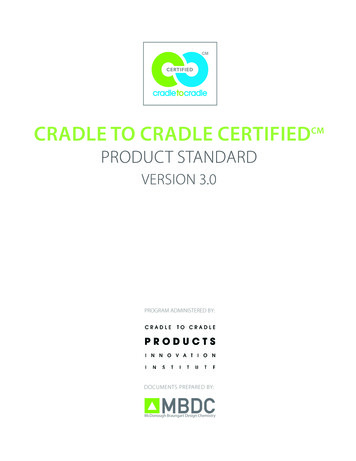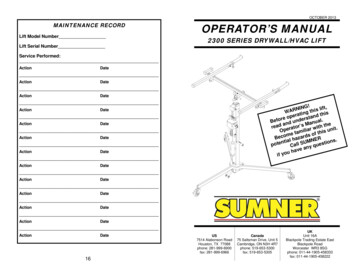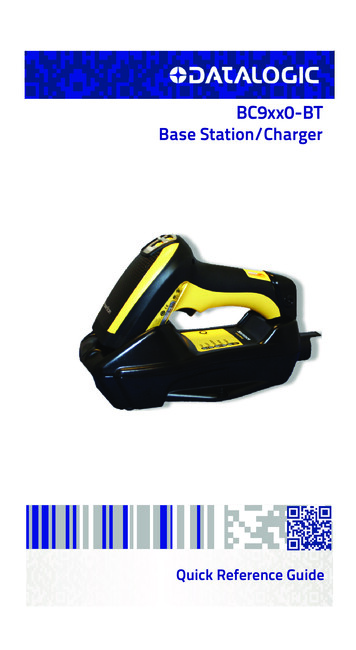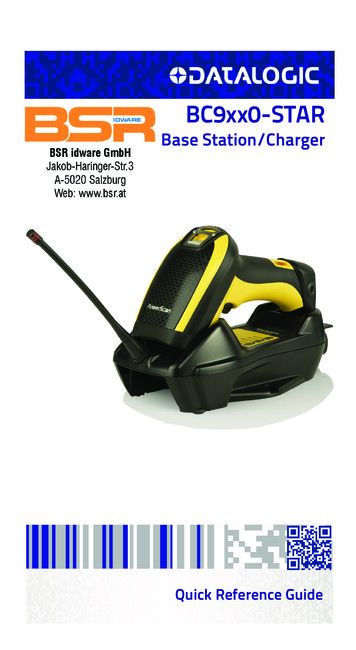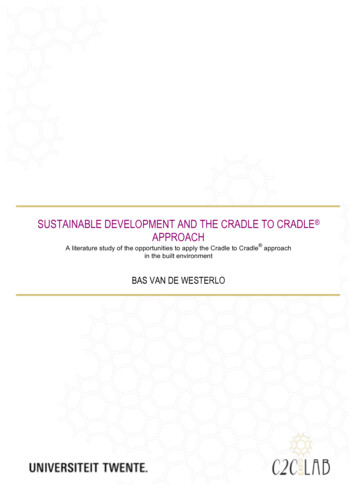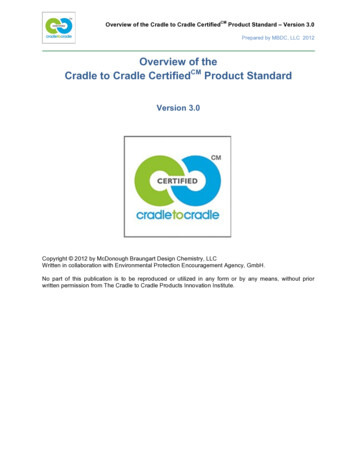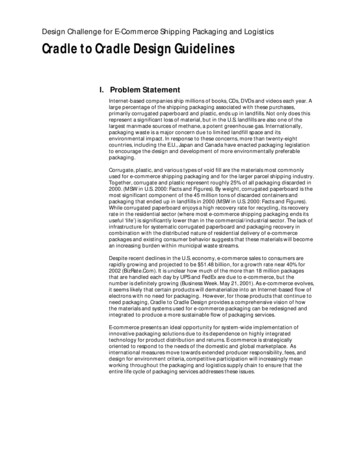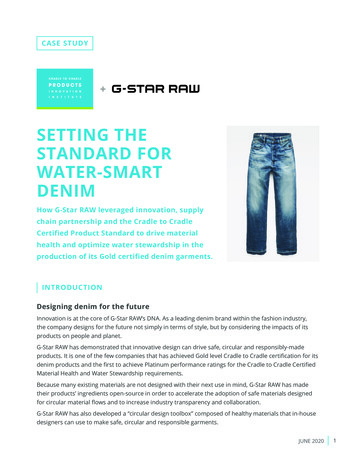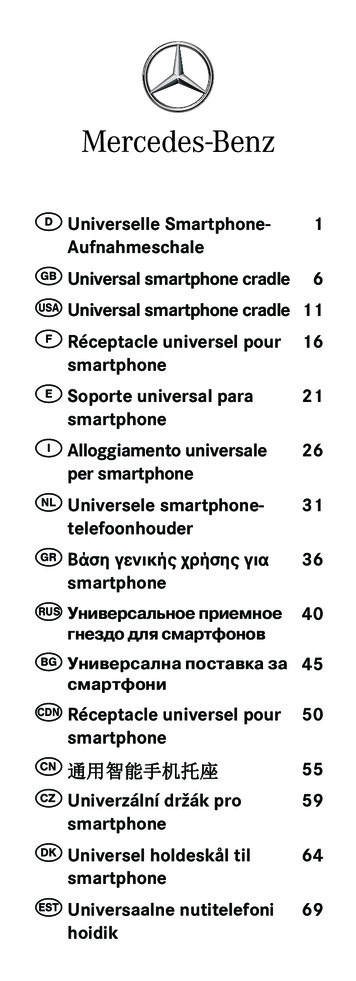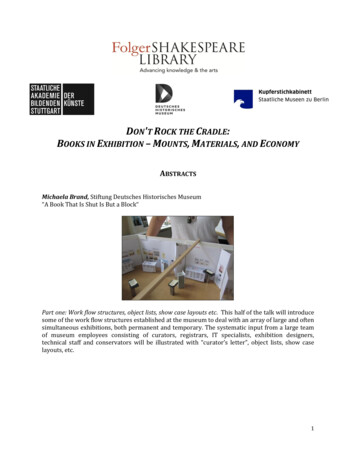
Transcription
DON'T ROCK THE CRADLE:BOOKS IN EXHIBITION – MOUNTS, MATERIALS, AND ECONOMYABSTRACTSMichaela Brand, Stiftung Deutsches Historisches Museum“A Book That Is Shut Is But a Block“Part one: Work flow structures, object lists, show case layouts etc. This half of the talk will introducesome of the work flow structures established at the museum to deal with an array of large and oftensimultaneous exhibitions, both permanent and temporary. The systematic input from a large teamof museum employees consisting of curators, registrars, IT specialists, exhibition designers,technical staff and conservators will be illustrated with “curator’s letter”, object lists, show caselayouts, etc.1
Don't Rock the Cradle: Books in Exhibition – Mounts, Materials, and EconomyAbstractsPart two: Curiosities and extra challenging cases and displays. This half of the talk will presentcuriosities and examples of extra challenging cases such as displaying badly damaged loan patientsor formats ranging from XXS to XXL.Prof. Uwe Brückner, Atelier Brückner“To Make a Book Talk – Access to Hidden or Secret Worlds“Image credit: Volker MaiScenography creates form from content, endowing the latter with meaning and attitude; it recontextualizes, makes things talk and imbues them with relevance for the presence. An example of howto give access to the hidden world of a book can be found in the exhibition at Schloss Dyck in Jüchen,Germany. This exhibition on horticulture shows the origins and development of the English landscapedgarden at Schloss Dyck. The central exhibit is Prince Joseph’s book of plants which contains his botanicaland architectural landscape gardening records from the 18th century. All parts of the book areaccessible via a double page opened up for the reader with the book protected in a showcase as thecentre of the installation as well as facsimiles of each page lining the walls, creating a narrative spaceand a reading level at the same time.A very different example of how to exhibit books can be found at the State Museum of Textile andIndustry in Augsburg, Germany. The museum’s valuable pattern book collection with its 1.3 millionfabric patterns dating from 1780 until the late 20th century is set in scene in the middle building. In the“accessible pattern book archive”, the visitor is immersed in the variety of small-format motifs. Largerthan-life figurines then present them in the spatial setting. Different aspects of the textiles are illustratedin each case, namely the haptics, the printed pattern and the cut of the different fabrics. At a mediastation, the visitor can choose from a set of digitized patterns and design a dress for the Thalia figurine.The significance and function of the fabric patterns are thus made comprehensible.2
Don't Rock the Cradle: Books in Exhibition – Mounts, Materials, and EconomyAbstractsBrenna Campbell & Bill Voss, University of Iowa“Wundercradle: On-Site Construction of Custom Exhibit Mounts”In October 2013, two members of the University of Iowa Libraries Conservation staff traveled toGrinnell College's Faulconer Gallery, where they spent seven days installing the exhibition "FromWunderkammer to the Modern Museum, 1606-1884". Ninety three items from the collection ofFlorence Fearrington were unpacked, checked for condition problems, and prepared for exhibition.Seventy-six custom book mounts were constructed on-site using Vivak . The books ranged in sizefrom less than three inches to huge elephant folios. Many of the books had elaborate foldoutillustrations, which required additional support. Planning and executing installation of this exhibitrequired careful estimation of the materials, tools, and time required. Working on-site presentedunique challenges, and inspired creative use of limited space and simple resources.Jim Canary, Indiana University, Bloomington“Miniature Books on Display”Through two acquisitions, the Lilly Library obtained over 16,000 miniature books. In 2001, anexhibition of more than 900 books was prepared to coincide with the Miniature Book Society’sConclave held in Indianapolis. Mounting this exhibit posed unique challenges due to the difficultyin displaying content in a book no larger than 3 cm. Preparing mounts and strapping booksaveraging 2 cm required an exploration of materials and techniques not previously used before. Avariety of mounts were developed for this exhibition and then adapted for use in other types ofexhibitions such as comic books.3
Don't Rock the Cradle: Books in Exhibition – Mounts, Materials, and EconomyAbstractsKaare Chaffee and Lisa Moberg, Library of Congress“Books on View”Hundreds of books representing virtually all regions and time periods from the collections of theLibrary of Congress go on exhibition every year. Dedicated staff ensures that they are displayedsafely. Kaare Chaffee and Lisa Moberg will discuss the basic functions of the exhibition program,how they evaluate and measure books for display, and the process of obtaining the various supportsystems used in the exhibition cases. They work closely with book conservators on staff to examineeach candidate, identify individual issues that require accommodations, and communicate theseneeds to contractors designing and creating the cradles. They will discuss the pros and cons of thepresent system as well as share examples of solutions used in various situations.Lesa Dowd, Newberry Library“The [R]evolving Display: Exhibitions at the Newberry Library “As with many libraries and museums, the Newberry has dedicated exhibition space and hosts 2-3exhibitions per year. Conservation staff works with curators and exhibition staff to design caselayouts and determine angles of opening and display for books on exhibit. Responsibility for bookcradle design and construction, matting, framing, and preparation of flat materials and artifacts lieswith Conservation Services. Additionally, Conservation staff installs all books and collectionmaterials, monitors the environment, and sets lights for each exhibition. This presentation willfocus on the evolution of exhibitions and exhibit preparation at the Newberry Library leading up tocurrent practices. Finally, the presentation will reveal how the Newberry Library prepares its booksand other collections for exhibition on a limited budget, balancing the needs for aesthetic displaywith the priority of preserving the collections.4
Don't Rock the Cradle: Books in Exhibition – Mounts, Materials, and EconomyAbstractsDebra Evans, Fine Arts Museum of San Francisco“Making Books Stand Up and Stand Out”In 2001, the Fine Arts Museums of San Francisco opened the Logan Gallery at the Legion of HonorMuseum for the display of illustrated books. In the past fourteen years conservators at the Legion ofHonor have developed safe ways to display books in an upright position, per the original curator’swishes, so that the cover and one or more page openings can be viewed simultaneously. Simpleacrylic or low cost polyethylene terepthalate supports expand the safe and attractive options forbook installations. This presentation describes their construction and shows examples of their use.It also shows methods, including the use of rare earth magnets, which enable books to be displayedwith very little visible means of support. The talk will be illustrated with many examples ofsolutions for book display.Maria Fredericks, Morgan Library & Museum“Book Cradles for Exhibition – Access, Aesthetics and Preservation”An active program of exhibitions and loans is the primary point of contact between the Morgan’sholdings and the public. Each year, several hundred printed books, bound manuscripts, and artists’sketchbooks are displayed in five different in-house galleries, and many more are shown at externalvenues. The need to present bound materials in an intellectually stimulating, visually appealing, andfully accessible way sometimes challenges the preservation imperative. While all aspects ofexhibition development address these combined mandates, it is the humble and often unnoticedbook cradle that shoulders much of the load, both metaphorically and physically. This presentationwill provide an overview of the Morgan’s exhibition preparation and design process, and theconservator’s role as part of the exhibition team. The interdependency of cradle costs, productiontime, space needs and design requirements will be discussed in the context of safe and sustainableexhibition practice.5
Don't Rock the Cradle: Books in Exhibition – Mounts, Materials, and EconomyAbstractsHanka Gerhold, Kupferstichkabinett“From Function to Design – Requirements for Book Supports”A basic introduction from the conservator’s point of view, starting from the differences of variousbook structures, its characteristic weak points, mechanical strength and opening characteristic tothe construction of book supports and the variety of structural forms.Hanka Gerhold, Kupferstichkabinett“Well Presented and Secured: an Overview of Book Cradles in Exhibition Display“An intensive graduate research enabled in 2012 the compilation of around 20 different models ofbook supports. The collection, which includes handmade as well as custom made book supports, isstructured according to the different materials of which book supports are constructed, includingcardboard, textiles, plastics, and metal.Emily Jacobson, Smithsonian Museums, Sackler Gallery“Cradles for Bound Japanese Books”In 2013 the Sackler Gallery of Art held an exhibition on Japanese books from the Gerhard Pulverercollection. With over 125 books in the exhibition, most being shown open, the museum needed tofind a way to construct book cradles that would give adequate support to the book yet could beproduced fairly quickly. The Freer and Sackler Galleries are lucky to have a talented staff of mountmakers who undertook the task of making these Plexiglas cradles. Looking at the books together,the conservator and mount makers came up with three designated categories of books which wouldfit three different styles of Plexiglas cradles. The cradles will be shown and their strengths andweaknesses discussed.6
Don't Rock the Cradle: Books in Exhibition – Mounts, Materials, and EconomyAbstractsShan Linde, National Gallery of Art“When All Else Fails – Back to the Basics”This presentation will be a review of the book cradles used in exhibitions at the National Gallery ofArt. These cradles are designed to both support the books and meet the desires of the exhibitiondesigner, curator, and conservator. Additional considerations include creating supports for multipage openings as well as single page supports using a variety of preservation and conversationmaterials such as Vivak. The use of HDPE as a base support for fabric or mat board and what typeof adhesives work for this will also be considered.Nora Lockshin & Sarah Stauderman, Smithsonian Institution Archives“Opposites Attract: Magnets in Mounts”The Smithsonian Institution Archives holds many physical types of archival record, including manybound and unbound (in binder's terms) pamphlet and ephemeral styles, which have presentedchallenges when requested for digitization or exhibition. Sarah Stauderman and Nora Lockshin willpresent some of their challenges, imaginative solutions and improvements they have offered tocurators, designers and imaging services recently, including integration of magnets for displayopenings.7
Don't Rock the Cradle: Books in Exhibition – Mounts, Materials, and EconomyAbstractsRenate Mesmer, Folger Shakespeare Library“It’s All about That Base: a Decade of Mounting Books at the Folger in Review“Over the past ten years, exhibit installation at the Folger has gone through multiple modifications.Changes in how to support bound artifacts, exhibition design, aesthetic preferences, and caseoptions and appearances has required flexibility and reinvention on the part of the FolgerConservation staff. Additional concerns of reusability and cost have also played their role in theeventual concept of the bases and mounts currently utilized. This talk will give a general overviewof the previous mounting efforts of Folger Conservation staff; discuss why the changes came aboutthe way they did, touch on the renovation of the exhibition space including the replacement of thewindows and reintroducing daylight, light budgeting and detail the current philosophy andconstruction of the Folger book mount.Kerri Sancomb & Christine McCarthy, Yale University“Mounts and More: a Systematic Approach to the Care and Display of Book in Library Exhibitions “Yale University Library conservation and exhibit services produces 14 to 20 exhibits annually in 5venues containing 1200 to 2000 objects. Over time, an efficient mounting system was developedthat is low maintenance and generally reusable. Our mount production model is simple anddeveloped to meet 80% of book mount needs with two simple book supports. A standard M mountand a flat bottomed M mount constructed from Vivak and 4 ply mat board. This moderatelycustomizable system allows us to create book mounts for the majority of the objects in little time,allowing us more time to focus on customized mount needs. Conservation is thus able toaccommodate the broad needs of a large exhibit program while not compromising our baseline ofcare. In our talk we will go into detail about the history behind our current system and the toolsthat we use to accomplish our goals.8
Don't Rock the Cradle: Books in Exhibition – Mounts, Materials, and EconomyAbstractsNicole Schmidt, Stiftung Flucht, Vertreibung, Versöhnung“Challenges of a Registrar”This talk from the registrar’s point of view will present an inside glimpse of the preparation ofcomplex museum objects exhibitions and might add a new perspective to pure book exhibitions.This talk will present insight into the challenges a registrar faces when looking at a wide array ofissues such as loan contract negotiations, diplomacy, insurance, art handlers, logistics, customs andmore.Nancy Turner, J. Paul Getty Museum“Displaying Medieval Manuscripts at the Getty Museum: Conservation Concerns, Practicalities, andCradle Designs for Permanent Collection Rotations and Temporary Loan Exhibitions “This presentation will describe the creation of custom-fit book mounts for medieval illuminatedmanuscripts exhibited at the J. Paul Getty Museum, both for the permanent gallery devoted torotating displays of manuscripts from the Museum’s collection and for special temporary loanexhibitions. In collaboration with exhibition designers at the Museum, two types of cradles weredeveloped to accommodate these different requirements: a painted Plexiglas cradle for thepermanent collection (contracted out), and a pieced cradle of different but visually similarmaterials for use in loan exhibitions whose flexible design allows for last minute changes ifnecessary (made in-house). With the safe display of illuminated manuscripts on parchment ofparamount concern, the issues of design, cost, materials, off-gassing and testing, along with re-useand recyclability will be discussed. Moreover, the process of communicating with and elicitingaccurate information from outside lenders for the construction of cradles for in-coming loans willbe addressed.9
Don't Rock the Cradle: Books in Exhibition – Mounts, Materials, and Economy Abstracts 5 Debra Evans, Fine Arts Museum of San Francisco “Making Books Stand Up and Stand Out” In 2001, the Fine Arts Museums of San
